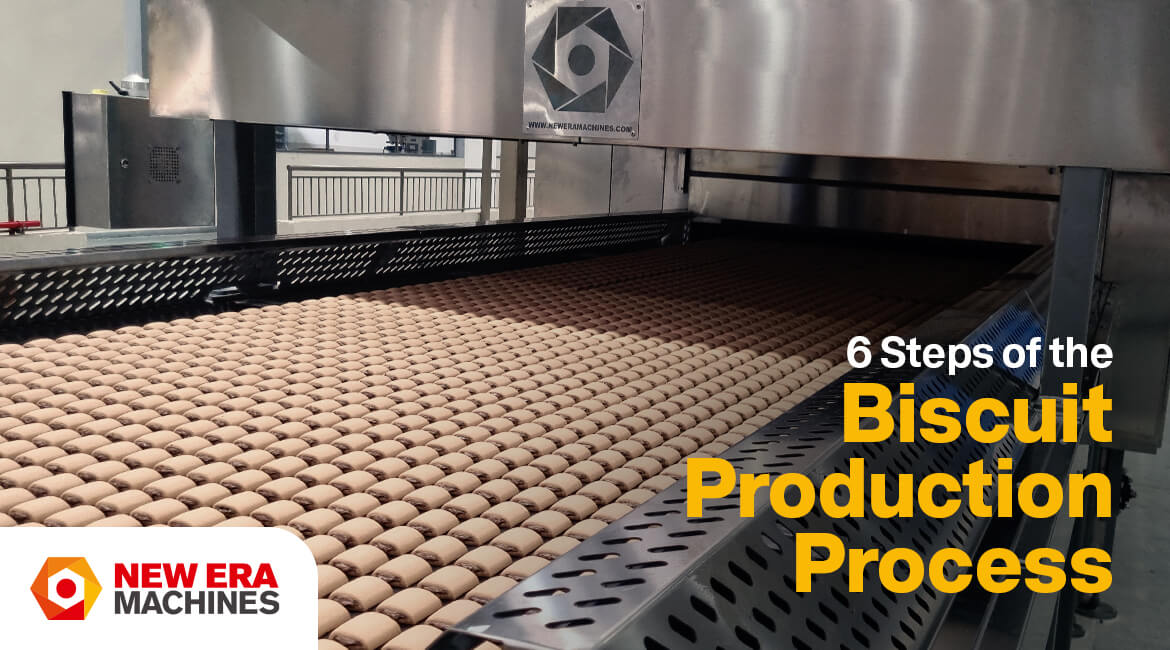6 Steps of the Biscuit Production Process
The word “biscuit” is derived from the Latin word panis biscoctus which means ‘twice-baked bread’. Biscuit refers to a wide variety of flour-baked products, though it is typically an unleavened cake or bread that is crisp and dry in nature and is small, thin, and flat. Biscuits evolved from various baking techniques such as tarts, pastries, shortcakes, and sugar confectionery. They were responsible for the development of the wafer, macaroon, cracker, sandwich, snap, gingerbread, honey cake, rusk, and water biscuit. Biscuits are classified into two types. The first is either plain or flavoured with something savoury. The second type has a sweet or semi-sweet flavour.
Most biscuits are distinguished by their shape: round, square, oblong, finger-shaped, or ornately decorated. To increase crispness during baking, plain biscuits are typically punched with a cutter or docker. Sugar, icing, or chocolate coating (full or partial) can be applied to fancy biscuits.
The biscuit making process is elaborate and continuous. The ingredients are combined to form a dough, which is kneaded and rolled to a uniform thickness. It is cut into biscuit shapes and placed in a travelling oven. Some biscuits necessitate special preparation and cooking methods.
The Biscuit Manufacturing Process
There are 6 steps in which the biscuit production process happens:
Step 1: Making the Dough
All of the ingredients are mixed and poured into the mixer in this section. At this stage, the type of ingredient, the order in which it is mixed, the quantity, and the temperature all matter. Each ingredient is significant and performs a specific function. The variables among the ingredients are water and ammonium bicarbonate (ABC), with water used for dough making and ABC used to increase the height of the biscuits. The New Era Machines‘ dough mixer is the main piece of equipment used in the process. Depending on your needs, you can get a spiral, vertical, or horizontal mixer.
Step 2: Fermentation
After the dough has been mixed, yeast is added. Some brands do this while the dough is being prepared, while others wait until after the dough has been prepared. The fermentation process can take anywhere from 21 to 26 hours, allowing the dough to become light and airy. This is usually a manual process.
Step 3: Shaping and Molding
In terms of biscuit finishing and weight, it is a critical step in the manufacturing of biscuits as Large weight results in losses due to the buyer receiving more than deciding net weight. This extra weight that is packed in order to maintain the stated weight is referred to as a “giveaway.”
Before the dough is put in the mold, a knife is used to cut the dough into two or more pieces. There are two controls present: one for the knife in all four directions (up, down, forward, and back), and one for the press on both the left and right sides of the roller.
Step 4: Baking
Once the biscuits have been properly shaped, they are placed in a massive oven. This is typically accomplished with a conveyer belt, but it can also be accomplished manually. The task can be completed with New Era Machines’ Direct Gas Fired /oven, Convection Oven, Indirect Radiant, Cyclotherm Oven, and Hybrid Oven. Our extensive baking range provides ideal conditions for producing high-quality baked goods. Various options are available to improve performance and meet the needs of each customer. Each system is built to meet high-quality standards and ensures easy installation.
The oven is made up of several heating sources as well as a conveyor. The oven is controlled by a micro controller, which ensures that the temperature is precise and consistent for each batch. The oven also has a conveyor belt that transports the cookies once the baking process is finished.
Step 5: Cooling and Testing
It is critical to cool the biscuits before putting them through the testing process. The cooling of the biscuits is completed within the conveyor. Following that, a few biscuit samples are collected and sent for quality control. Apart from manual testing, all other types of testing like quality, weight, and safety are performed in a specific laboratory.
Step 6: Packaging and distribution
After cooling, the biscuits are transferred to a packaging machine, where the packing process is completed before they are sent to the market.
Bakery items, such as wafer biscuits, are made from maida, refined edible oil, table butter, desi butter, margarine, or ghee. Various established processes are commercially available and used by various manufacturers. There have been numerous advancements in the field of machinery and processes. Biscuits are one of the world’s most popular snacks, loved and enjoyed by people of all ages. They can be enjoyed with a cup of tea or coffee, milk, or simply on their own.
The manufacturing process may appear simple at first glance, but the most important aspect here are the machines used. These precise tools ensure consistency in every batch, which aids in the recognition of a biscuit brand. So, always choose the biscuit-making machines from one of the most trusted names in the industry, New Era Machines. With cutting-edge technologies and research, we are now one of India’s largest manufacturers of automated baking lines and systems, having launched our own biscuit lines in 1965. We have successfully served clients all over the world by incorporating outstanding quality for streamlined production and high performance machinery.



